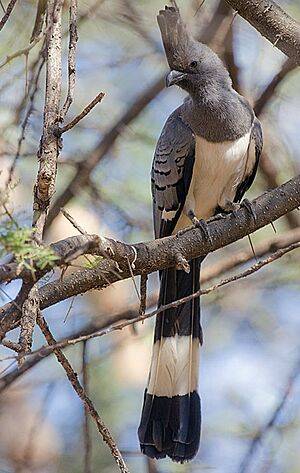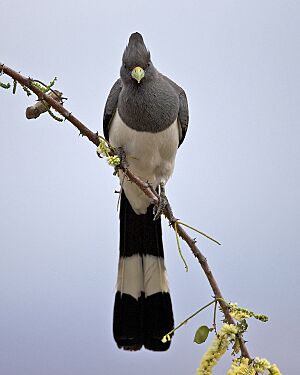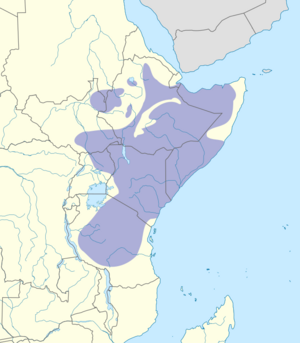White-bellied go-away-bird facts for kids
Quick facts for kids White-bellied go-away-bird |
|
|---|---|
 |
|
| In Tarangire National Park | |
 |
|
| In Tanzania | |
| Conservation status | |
| Scientific classification | |
| Genus: |
Crinifer
|
| Species: |
leucogaster
|
 |
|
| Approximate distribution
Year-round |
|
The white-bellied go-away-bird (Crinifer leucogaster) is a unique bird found in eastern Africa. It belongs to the family Musophagidae, which are often called turacos.
Contents
About the White-bellied Go-away-Bird
The white-bellied go-away-bird was first described in 1842 by a German scientist named Eduard Rüppell. This bird is part of the bird family called Musophagidae. This family includes other go-away-birds and plantain-eaters. People sometimes call them "banana-eaters."
These birds have a special feature: their fourth (outer) toe can move forward and backward. This helps them grip branches. Many birds in this family also have cool crests on their heads and long tails. Some turacos are even famous for their super bright colors!
What Does It Look Like?
This bird is about 51 centimeters (20 inches) long. It has a long, pointed tail that is grey and black with a white stripe in the middle. When it flies, you can see a white patch under its wings.
Adult birds have a grey head and a dark grey or black pointed crest about 6 centimeters long. Their belly and the feathers under their tail are white. This is why it's called the "white-bellied" go-away-bird.
The male bird has a black bill, while the female's bill is pea-green. It turns yellowish when she is ready to breed. Females are usually a bit bigger, weighing 225-250 grams. Males are lighter, weighing 170-225 grams. Young birds look similar to adults, but their feathers are more brownish, especially on their wings.
Its Special Call
The white-bellied go-away-bird makes a loud, nasal sound like "haa-haa-haa," which sounds a bit like a sheep. It also makes a distinct "gwa" or "g'away" call. This is how it got the "go-away" part of its name! These birds often fly from tree to tree in small groups, calling loudly as they go.
Where Do They Live?
These birds live in hot areas like acacia-steppe, savanna, and woodland. They don't usually go into thick forests. You can find them at different heights, from sea level up to 2000 meters.
White-bellied go-away-birds stay in their local areas. They only move around when they need to find water or food. They live across a large part of the Horn of Africa and nearby regions. You can find them in countries like Burundi, Djibouti, Eritrea, Ethiopia, Kenya, Rwanda, Somalia, South Sudan, Uganda, and eastern Tanzania.
How Do They Behave?
White-bellied go-away-birds are social birds. They don't migrate far but move in family groups of up to 10 birds. They are also territorial, meaning a breeding pair will likely protect their home area all year long.
What Do They Eat?
These birds mostly eat plants. Their diet includes fruits, flowers, nectar, seeds, and buds from acacia trees. They also sometimes eat small invertebrates, like winged termites they find while looking for food. They are very good at climbing, which helps them find food high up in trees. Sometimes, farmers see them as a pest because they might eat fruits and vegetables from orchards and farms.
Reproduction and Family Life
During the breeding season, which usually starts when the rainy season begins, white-bellied go-away-birds become much louder. This time can vary depending on where they live. They perform special courtship dances. They chase each other from tree to tree, bow, and flick their long tails while raising and lowering their crests. These movements show off their black and white patterns.
White-bellied go-away-birds are monogamous, meaning they have one partner. The male and female have been seen feeding each other.
The nest is built in an acacia-type tree, usually 3 to 12 meters above the ground. The female lays 2 or 3 pale bluish eggs. Both parents take turns sitting on the eggs for about 4 weeks. The young chicks take their first flight about 4 to 5 weeks after hatching. However, they still rely on their parents for food for several more weeks.
Is It Endangered?
The white-bellied go-away-bird is not considered endangered. Its population size is not known exactly, but it is believed to be large. The bird lives across a huge area, more than 3 million square kilometers. This means it doesn't meet the criteria for being vulnerable. Also, the number of these birds seems to be stable and not decreasing. So, its conservation status is "of least concern."
Gallery
-
Male in Kenya





